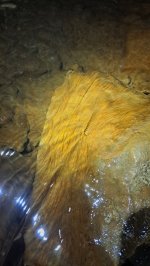I don't think it's an alga. Long filamentous algae would not grow to this extent in the complete absence of light (i.e. no photosythesis). It's extremely common for algae to enter caves in moving water (as most are unicellular) but they only usually become visible if either if there is an artificial light providing the energy for photosynthesis (e.g. show caves; the lampenflora effect) or if conditions locally cause them to accumulate in great numbers due to the sediment sorting effect of streams. (I once came across this in Malham Cove Rising where the floor of part of the sump was carpeted in green; after the next flood this had vanished. Fortunately I'd collected a sample to stick under a microscope which confirmed they were indeed a species of unicellular green alga.)
A bacterial growth seems far more likely - which suggests reasonably eutrophic water. This could result from muck spreading on the land above or from paper pulp spreading (although I think that's supposed to have been stopped now).
What I can confirm is that there was no such phenomenon seen on the day we originally explored Cliffhanger.
Get a sample and get it to someone who can use a microscope and would be able to recognise the culprit.
Is there an area on the land above or to the west where a lot of muck spreading has taken place this spring? If so, it might provide useful knowledge as to the catchment for this autogenic stream (which is otherwise difficult to trace with the usual methods used for allogenic sinks).






